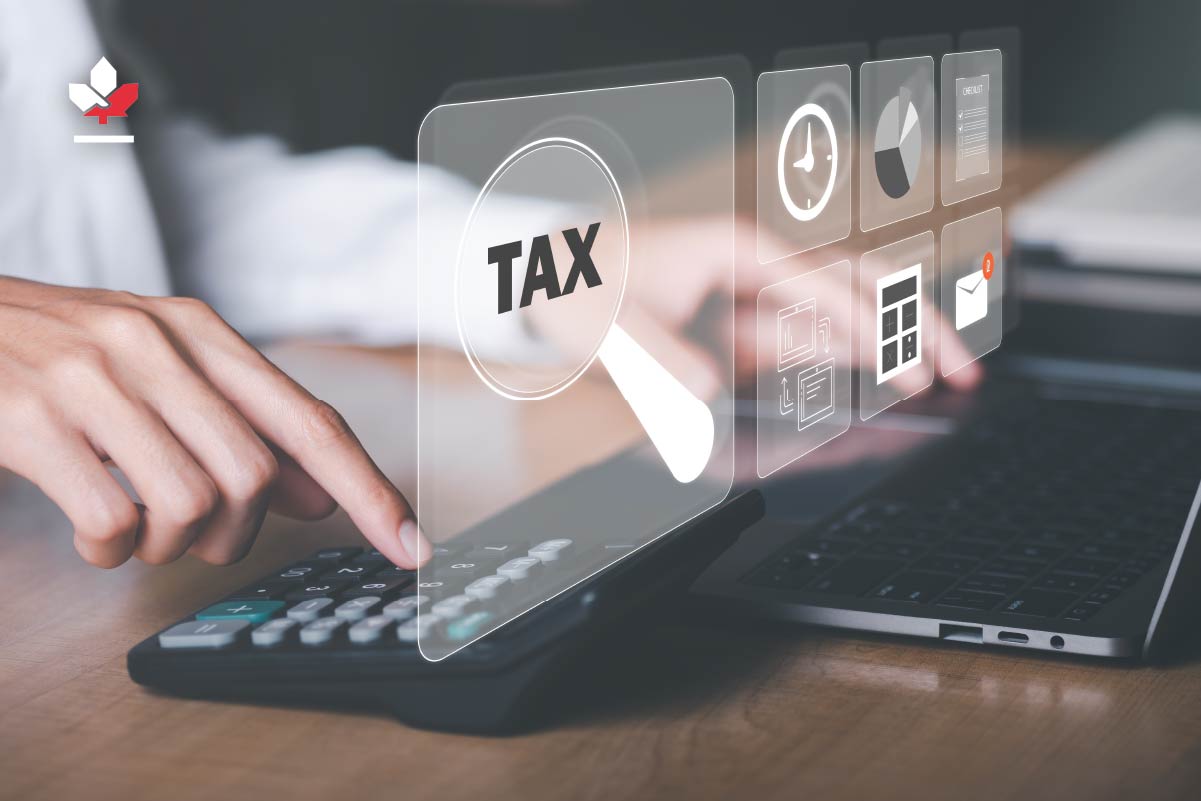The Newcomer's Guide to Taxes in Canada
May 10, 2024
|
Whether you are eagerly planning your move to Canada as a permanent resident or have just arrived, settling into a new life is an exciting adventure. But amidst the hustle and bustle, understanding taxes in Canada is an important step. This blog will be your one-stop guide to filing your taxes in your first year as a Canadian resident, ensuring a smooth and stress-free experience with the Canada Revenue Agency (CRA).
We will break down everything you need to know, from gathering documents to choosing the right filing method, so you can navigate the process with confidence. Let us get you started on your Canadian tax journey!
Demystifying Canada's Tax System

Canada operates on a progressive tax system, which means the more you earn, the higher the percentage of tax you contribute. This system helps fund essential public services like healthcare, education, and infrastructure. The CRA acts as the central tax authority, collecting income tax and administering various benefits and credits for eligible Canadians.
Am I Required to Submit a Tax Return as a Newcomer to Canada?
Even if you only resided here for part of the year, you may be required to file taxes in Canada. Here are some situations when filing is necessary.
- Tax Liability: If you owe taxes for the current tax year, filing a return ensures you fulfill your tax obligations.
- Potential Refund: If you paid taxes throughout the year (through payroll deductions, for example), filing a return allows you to claim any potential refunds you may be entitled to.
- Benefits and Credits: Filing a return opens the door to claiming valuable tax benefits and credit payments you might qualify for, such as the GST/HST credit.
Free Tax Assistance Programs
Canada offers several programs to assist newcomers with filing their tax returns, particularly if your income is modest and your tax situation is straightforward.
- Community Volunteer Income Tax Program (CVITP): This program connects you with volunteers who can help you file your return free of charge.
- Income Tax Assistance – Volunteer Program (Quebec): This program is specifically designed for residents of Quebec who require assistance with their tax filings.
Support for Self-Employed Newcomers
The CRA's Liaison Officer Service offers dedicated support to self-employed newcomers to Canada. This service can help you understand your tax obligations and navigate the specific requirements for self-employed individuals.
Who is Considered a Newcomer to Canada
There are various categories of newcomers to Canada for immigration purposes. These can include:
- Permanent Residents: This encompasses individuals who have received official confirmation of their permanent residency status, including those with "approval-in-principle" from Immigration, Refugees and Citizenship Canada (IRCC).
- Refugees: Individuals granted protected person status in Canada also fall under the newcomer category.
- Temporary Residents: This group includes students, workers, and individuals holding temporary resident permits.
Canadian Residency for Income Tax Purposes
When it comes to taxes for newcomers, the CRA focuses on residency for tax purposes. This can differ from your immigration status. For tax purposes, you're considered a newcomer in your first year of establishing residency in Canada. Residency is determined by having sufficient residential ties, which typically begin when you arrive in Canada.
If you are unsure whether you qualify as a resident of Canada for tax purposes, the CRA offers resources to help clarify your situation.
For a personalized assessment, consider completing Form NR74, titled "Determination of Residency Status (entering Canada)." Submitting this form to the CRA before your tax return deadline allows them to review your specific circumstances and provide an official determination.
For a deeper look into residency criteria, consult Income Tax Folio S5-F1-C1, available on the CRA website. This resource provides detailed information on how the CRA defines residency and the factors considered when making such determinations.
Residential Ties in Canada
Understanding your residential ties in Canada is crucial for determining your tax status. The CRA considers these ties when assessing whether you're a resident of Canada for tax purposes. These ties can be categorized as primary and secondary.
Primary Residential Ties
These are the most significant factors the CRA considers when determining residency. Having strong primary ties indicates a clear intention to reside in Canada long-term.
- Dwelling in Canada: Owning or leasing a home in Canada establishes a strong residential tie. This demonstrates a physical presence and investment in the country.
- Family Ties: Having a spouse or common-law partner or dependents residing in Canada significantly strengthens your residential ties. This suggests strong personal connections and roots within the country.
Secondary Residential Ties
While not as critical as primary ties, secondary ties can contribute to your overall residential status. These factors paint a broader picture of your connection to Canada.
- Personal Belongings: Owning personal property like a car or furniture in Canada suggests a connection to the country. Having established belongings indicates a likelihood of long-term residency.
- Social Involvement: Participating in Canadian social activities through memberships in recreational or religious organizations indicates ties to the community. Engaging with local social circles suggests an intention to integrate into Canadian life.
- Financial Ties: Having Canadian bank accounts, credit cards, or investments demonstrates a financial connection to Canada. These financial ties suggest an ongoing economic commitment to the country.
- Official Documents: Possessing a Canadian driver's license, passport, or provincial/territorial health insurance further strengthens your residential ties. Obtaining official Canadian documentation demonstrates a desire to be recognized as a resident.
Remember that the presence or absence of any single factor doesn't solely determine your residency. The CRA considers the totality of your circumstances when making this assessment.
Your Canadian Social Insurance Number (SIN)

As a newcomer to Canada, you'll encounter the concept of a Canadian Social Insurance Number (SIN). This unique nine-digit number acts as your identification for tax and benefit purposes within the country. It is confidential and should be safeguarded.
Why is a SIN Important?
The CRA uses your SIN to track income tax and benefit information. You must also provide it to anyone preparing tax slips for you, such as a T4 slip (employment income summary).
Who Needs a New SIN?
If you are transitioning to permanent residency and currently use one of the following, you must apply for a new SIN with Service Canada:
- Temporary SIN (starts with a "9")
- Temporary Tax Number (TTN) from the CRA
- Individual Tax Number (ITN) from the CRA
Once you receive your permanent SIN, discontinue using any previous SINs, TTNs, or ITNs.
Applying for a SIN
There are three convenient ways to apply for a SIN:
- Online: Apply online for a SIN and upload digital documents securely
- In Person: Visit your nearest Service Canada office to apply in person
- By Mail: You can also submit a mailed application
Matching Your Profile to the Correct Tax Package
Understanding tax packages is crucial for filing your Canadian income tax return accurately. The Canada Revenue Agency provides these packages to simplify the process, tailoring information specific to your situation. Think of it as a localized guidebook for navigating your tax obligations.
What is Inside a Tax Package?
Each tax package typically includes several key resources:
- Federal Tax Information: This section offers a comprehensive overview of federal tax rules, deductions, and credits applicable to all Canadian residents.
- Provincial or Territorial Information: This section dives deeper, detailing the specific tax rates, deductions, and credits relevant to your province or territory of residence as of December 31st of the tax year. These details can vary significantly across provinces, so using the correct package is essential.
- Income Tax Return Forms: These are the official forms you need to submit to the CRA. The package will include a general Income Tax and Benefit Return (T1) form and additional provincial or territorial schedules depending on your unique circumstances.
- Guides and Instructions: The package typically comes with booklets or pamphlets that provide step-by-step instructions on filling out the tax return forms and claiming the deductions and credits you're eligible for.
Why Matching Your Profile to the Right Package is Crucial
While Canadian tax filing might initially seem complex, one crucial element significantly impacts your return - selecting the appropriate tax package. Here is why it matters:
- Tax Rate Variations: Each province and territory sets its own tax rates on top of the federal tax rates. Using the wrong package can lead to miscalculating your total tax liability.
- Deduction and Credit Specificity: The availability and value of tax deductions and credits can differ between provinces and territories. Matching your situation with the correct package ensures you claim all the benefits you're entitled to in your specific location.
Ways to File Your Tax Return

Ready to submit your Canadian tax return? Great news! You can choose between convenient online filing or the traditional paper method.
Streamlined and Secure Filing Electronically
For a faster and more secure approach, consider electronic filing. Here are two options:
- NETFILE: This official Canada Revenue Agency service allows you to submit your return electronically using approved tax software or web applications. The CRA provides a list of these options, including some free ones.
- EFILE: This service lets authorized tax preparers, like discount tax companies, electronically file your return for you.
Traditional Paper Filing
If you are more comfortable with a paper-based approach, you can mail a completed tax return to the address provided by the CRA. Double-check the mailing instructions to ensure your return reaches the correct location.
FAQs
Why is it Important to File Taxes in Canada on Time?
The CRA emphasizes timely and accurate tax submissions. Filing your 2023 return late and owing taxes may result in a penalty. This penalty becomes more significant if you also neglect income reporting in previous years. Interest on any unpaid amount from your 2023 taxes begins accruing daily from May 1, 2024. This applies even if the CRA adjusts your return after submission.
What Kind of Tax Benefits and Credit Payments Can I Receive If I File Taxes in Canada?
The Canadian government offers various benefits and credit payments to assist individuals and families with living expenses, including those new to Canada. To qualify, you may need to file your first Canadian tax return or apply for specific programs like the Canada Child Benefit or the GST/HST credit.
Remember, filing your tax return annually is crucial to continue receiving these benefits and credits you may be entitled to. Some common examples include the GST/HST credit, which provides quarterly payments to help offset sales tax costs, the Canada Carbon Rebate for residents in participating provinces to combat pollution pricing costs, and the Canada Child Benefit, offering monthly support for raising children.
